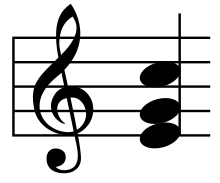First inversion
The first inversion of a chord is the voicing of a triad, seventh chord, or ninth chord with the third of the chord in the bass and the root a sixth above it.[1] In the first inversion of a C-major triad ![]() Play , the bass is E—the third of the triad—with the fifth and the root stacked above it (the root now shifted an octave higher), forming the intervals of a third and a sixth above the inverted bass of E, respectively.
Play , the bass is E—the third of the triad—with the fifth and the root stacked above it (the root now shifted an octave higher), forming the intervals of a third and a sixth above the inverted bass of E, respectively.





History
In early music, what is today called a sixth chord or first inversion in classical music was considered an autonomous harmonic entity with the root named by the bass, while it was later simply considered an inversion of a chord with the bass being the third (not the root) and the root being the sixth (not the bass).
Special kinds of sixth chords
The Neapolitan sixth is a root-position minor subdominant triad with its fifth displaced upward to the flatted supertonic (second degree of the scale) – a Neapolitan sixth in C minor, therefore, consists of the notes F, A♭ and D♭. ![]() Neapolitan sixth chord preceding authentic cadence (V-I)
Neapolitan sixth chord preceding authentic cadence (V-I)
There are a number of augmented sixth chords. Each of them has a major third and augmented sixth above the bass. When these are the only three notes present, the chord is an Italian sixth
![]() Italian sixth moving to V. ; when an augmented fourth is added above the bass, the chord is a French sixth
Italian sixth moving to V. ; when an augmented fourth is added above the bass, the chord is a French sixth ![]() French sixth moving to V. ; while adding a perfect fifth above the bass of an Italian sixth makes it a German sixth
French sixth moving to V. ; while adding a perfect fifth above the bass of an Italian sixth makes it a German sixth ![]() German sixth moving to V (the etymology of all these names is unclear). All usually have the flatted submediant in major keys (sixth degree of the scale, A flat in C major, for example), but the normal minor-sixth submediant in minor keys (A flat in C minor, for example) as the bass note. In this case, they tend to resolve to the dominant. Another related chord with an augmented sixth is the Tristan chord.
German sixth moving to V (the etymology of all these names is unclear). All usually have the flatted submediant in major keys (sixth degree of the scale, A flat in C major, for example), but the normal minor-sixth submediant in minor keys (A flat in C minor, for example) as the bass note. In this case, they tend to resolve to the dominant. Another related chord with an augmented sixth is the Tristan chord.
See also
References
- ↑ Walter Piston, Harmony, fifth edition, revised and expanded by Mark DeVoto (New York: W. W. Norton, 1987): p. 66. ISBN 978-0-393-95480-7.
| ||||||||||||||||||||||||||||||||||||||||||||||||||||||